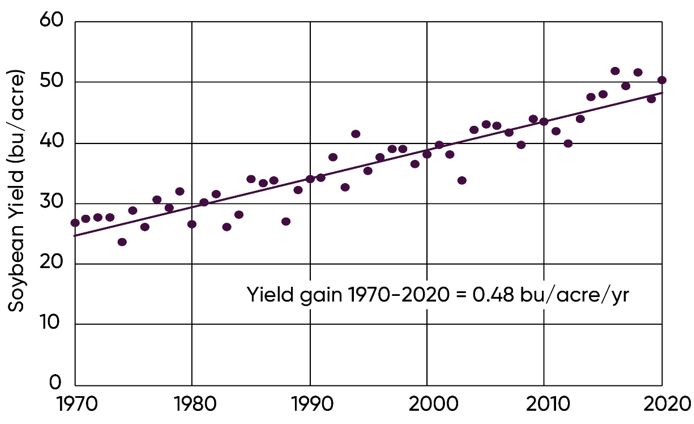3/2/2021
Achieving 100 bu/acre Yields in Soybeans
3/2/2021

Figure 1. U.S. average soybean yields 1970-2020 (USDA-NASS).

Figure 2. Series of Pioneer brand soybean varieties used in Pioneer on-farm trial entries exceeding 100 bu/acre, 2013-2020.
Table 1. Pioneer brand soybean varieties used in 2020 Pioneer on-farm trials entries exceeding 100 bu/acre.


Pioneer® brand soybean varieties topping 100 bu/acre in on-farm trials in 2020 included:
Previous Crop
Tillage

Figure 3. Tillage practices used in Pioneer on-farm trials with entries exceeding 100 bu/acre, 2013-2020.


Figure 4. Seeding rate used in Pioneer on-farm trials with entries exceeding 100 bu/acre, 2013-2020.
"Analyses of management practices used in yield contest winners in other crops have produced similar findings, indicating that there is no single one-size-fits-all formula for achieving high yield potential."
Seeding Rate

Figure 5. Row spacing used in Pioneer on-farm trials with entries exceeding 100 bu/acre, 2013-2020.
Row Spacing
Planting Date

Figure 6. Planting date of Pioneer on-farm trials with entries exceeding 100 bu/acre, 2013-2020.
Other Practices







Liberty®, LibertyLink® and the Water Droplet Design are registered trademarks of BASF. Varieties with the LibertyLink® gene (LL) are resistant to Liberty® herbicide. Roundup Ready 2 Xtend® is a registered trademark of Monsanto Technology LLC used under license. The transgenic soybean event in Enlist E3®®soybeans is jointly developed and owned by Dow AgroSciences LLC and M.S. Technologies L.L.C.
Varieties with the Glyphosate Tolerant trait contain genes that confer tolerance to glyphosate herbicides. Glyphosate herbicides will kill crops that are not tolerant to glyphosate.
Always follow stewardship practices in accordance with the Product Use Guide (PUG) or other product specific stewardship requirements including grain marketing and pesticide label directions. Varieties with BOLT® technology provide excellent plant-back flexibility for soybeans following application of SU (sulfonylurea) herbicides such as DuPont™ LeadOff® or DuPont™ Basis® Blend as a component of a burndown program or for double-crop soybeans following SU herbicides such as DuPont™ Finesse® applied to wheat the previous fall.
Varieties with the DuPont™ STS® gene (STS) are tolerant to certain SU (sulfonylurea) herbicides. This technology allows post-emergent applications of DuPont™ Synchrony® XP and DuPont™ Classic® herbicides without crop injury or stress (see herbicide product labels). NOTE: A soybean variety with a herbicide tolerant trait does not confer tolerance to all herbicides. Spraying herbicides not labeled for a specific soybean variety will result in severe plant injury or plant death. Always read and follow herbicide label directions and precautions for use.
DO NOT APPLY DICAMBA HERBICIDE IN-CROP TO SOYBEANS WITH Roundup Ready 2 Xtend® technology unless you use a dicamba herbicide product that is specifically labeled for that use in the location where you intend to make the application. IT IS A VIOLATION OF FEDERAL AND STATE LAW TO MAKE AN IN-CROP APPLICATION OF ANY DICAMBA HERBICIDE PRODUCT ON SOYBEANS WITH Roundup Ready 2 Xtend® technology, OR ANY OTHER PESTICIDE APPLICATION, UNLESS THE PRODUCT LABELING SPECIFICALLY AUTHORIZES THE USE. Contact the U.S. EPA and your state pesticide regulatory agency with any questions about the approval status of dicamba herbicide products for in-crop use with soybeans with Roundup Ready 2 Xtend® technology.
ALWAYS READ AND FOLLOW PESTICIDE LABEL DIRECTIONS. Soybeans with Roundup Ready 2 Xtend® technology contain genes that confer tolerance to glyphosate and dicamba. Glyphosate herbicides will kill crops that are not tolerant to glyphosate. Dicamba will kill crops that are not tolerant to dicamba.
Corteva Agriscience is a member of Excellence Through Stewardship® (ETS). Corteva Agriscience products are commercialized in accordance with ETS Product Launch Stewardship Guidance and in compliance with the Corteva Agriscience policies regarding stewardship of those products. In line with these guidelines, our product launch process for responsible launches of new products includes a longstanding process to evaluate export market information, value chain consultations, and regulatory functionality. Growers and end-users must take all steps within their control to follow appropriate stewardship requirements and confirm their buyer’s acceptance of the grain or other material being purchased. For more detailed information on the status of a trait or stack, please visit www.biotradestatus.com.
Excellence Through Stewardship® is a registered trademark of Excellence Through Stewardship.
Pioneer® brand products are provided subject to the terms and conditions of purchase which are part of the labeling and purchase documents.
The foregoing is provided for informational use only. Please contact your Pioneer sales professional for information and suggestions specific to your operation. Product performance is variable and depends on many factors such as moisture and heat stress, soil type, management practices and environmental stress as well as disease and pest pressures. Individual results may vary.
ALWAYS READ AND FOLLOW PESTICIDE LABEL DIRECTIONS. Soybeans with Roundup Ready 2 Xtend® technology contain genes that confer tolerance to glyphosate and dicamba. Glyphosate herbicides will kill crops that are not tolerant to glyphosate. Dicamba will kill crops that are not tolerant to dicamba.
Corteva Agriscience is a member of Excellence Through Stewardship® (ETS). Corteva Agriscience products are commercialized in accordance with ETS Product Launch Stewardship Guidance and in compliance with the Corteva Agriscience policies regarding stewardship of those products. In line with these guidelines, our product launch process for responsible launches of new products includes a longstanding process to evaluate export market information, value chain consultations, and regulatory functionality. Growers and end-users must take all steps within their control to follow appropriate stewardship requirements and confirm their buyer’s acceptance of the grain or other material being purchased. For more detailed information on the status of a trait or stack, please visit www.biotradestatus.com.
Excellence Through Stewardship® is a registered trademark of Excellence Through Stewardship.
Pioneer® brand products are provided subject to the terms and conditions of purchase which are part of the labeling and purchase documents.
The foregoing is provided for informational use only. Please contact your Pioneer sales professional for information and suggestions specific to your operation. Product performance is variable and depends on many factors such as moisture and heat stress, soil type, management practices and environmental stress as well as disease and pest pressures. Individual results may vary.